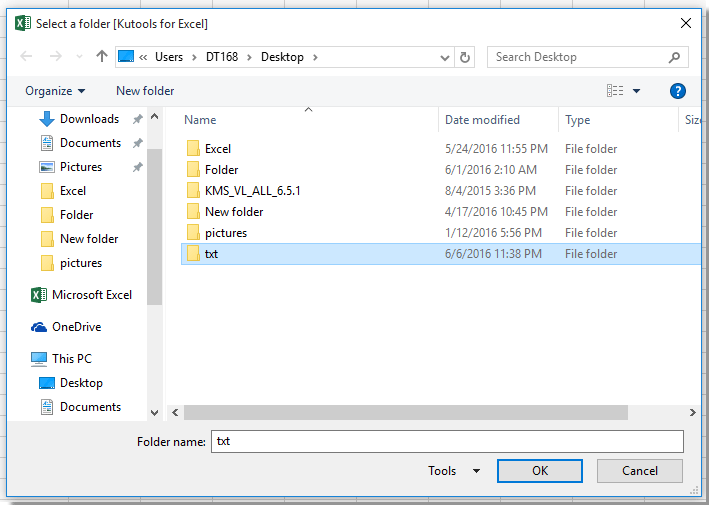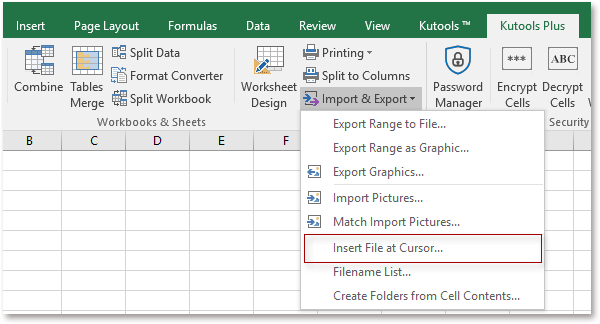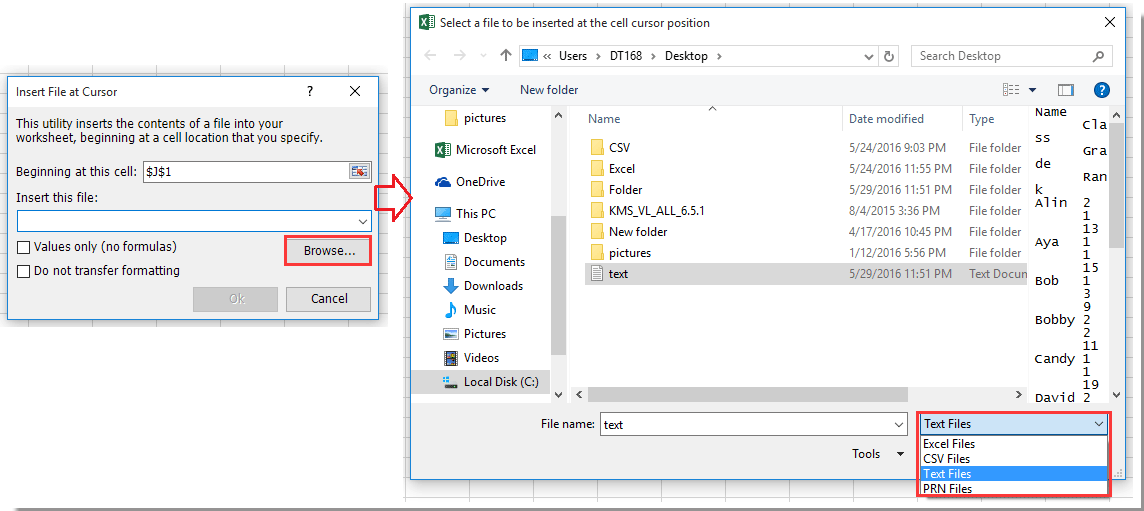Wie kann man mehrere Textdateien aus einem Ordner in ein Arbeitsblatt importieren?
Angenommen, Sie haben einen Ordner mit mehreren Textdateien und möchten diese in ein einzelnes Arbeitsblatt importieren, wie im folgenden Screenshot gezeigt. Anstatt die Textdateien einzeln zu kopieren, gibt es Tricks, um die Textdateien schnell aus einem Ordner in ein Blatt zu importieren?
Mehrere Textdateien aus einem Ordner mit VBA in ein einzelnes Blatt importieren
Textdatei mit Kutools für Excel in die aktive Zelle importieren ![]()
Mehrere Textdateien aus einem Ordner mit VBA in ein einzelnes Blatt importieren
Hier ist ein VBA-Code, der Ihnen helfen kann, alle Textdateien aus einem bestimmten Ordner in ein neues Blatt zu importieren.
1. Öffnen Sie die Arbeitsmappe, in die Sie Textdateien importieren möchten, und drücken Sie Alt + F11, um das Fenster Microsoft Visual Basic for Applications zu öffnen.
2. Klicken Sie auf Einfügen > Modul, kopieren Sie den folgenden VBA-Code und fügen Sie ihn in das Modulfenster ein.
VBA: Mehrere Textdateien aus einem Ordner in ein Blatt importieren
Sub Test()
'UpdatebyExtendoffice6/7/2016
Dim xWb As Workbook
Dim xToBook As Workbook
Dim xStrPath As String
Dim xFileDialog As FileDialog
Dim xFile As String
Dim xFiles As New Collection
Dim I As Long
Set xFileDialog = Application.FileDialog(msoFileDialogFolderPicker)
xFileDialog.AllowMultiSelect = False
xFileDialog.Title = "Select a folder [Kutools for Excel]"
If xFileDialog.Show = -1 Then
xStrPath = xFileDialog.SelectedItems(1)
End If
If xStrPath = "" Then Exit Sub
If Right(xStrPath, 1) <> "\" Then xStrPath = xStrPath & "\"
xFile = Dir(xStrPath & "*.txt")
If xFile = "" Then
MsgBox "No files found", vbInformation, "Kutools for Excel"
Exit Sub
End If
Do While xFile <> ""
xFiles.Add xFile, xFile
xFile = Dir()
Loop
Set xToBook = ThisWorkbook
If xFiles.Count > 0 Then
For I = 1 To xFiles.Count
Set xWb = Workbooks.Open(xStrPath & xFiles.Item(I))
xWb.Worksheets(1).Copy after:=xToBook.Sheets(xToBook.Sheets.Count)
On Error Resume Next
ActiveSheet.Name = xWb.Name
On Error GoTo 0
xWb.Close False
Next
End If
End Sub3. Drücken Sie F5 , um ein Dialogfeld anzuzeigen, und wählen Sie einen Ordner aus, der die Textdateien enthält, die Sie importieren möchten. Siehe Screenshot:
4. Klicken Sie auf OK. Dann wurden die Textdateien als neue Blätter separat in die aktive Arbeitsmappe importiert.
Textdatei mit Kutools für Excel in die aktive Zelle importieren
Wenn Sie eine Textdatei in eine bestimmte Zelle oder einen bestimmten Bereich importieren möchten, können Sie das Hilfsprogramm „Datei an Cursor einfügen“ von Kutools für Excel verwenden.
Nach der kostenlosen Installation von Kutools für Excel gehen Sie bitte wie folgt vor:
1. Wählen Sie eine Zelle aus, in die Sie die Textdatei importieren möchten, und klicken Sie auf Kutools Plus > Import/ Export > Datei an Cursor einfügen. Siehe Screenshot:
2. Es öffnet sich ein Dialogfeld. Klicken Sie auf Durchsuchen , um das Wählen Sie eine Datei aus, die an der Cursorposition eingefügt werden soll, und wählen Sie als Nächstes Textdateien aus der Dropdown-Liste aus und wählen Sie dann die Textdatei aus, die Sie importieren möchten. Siehe Screenshot:
3. Klicken Sie auf Öffnen > OK, und die angegebene Textdatei wurde an der Cursorposition eingefügt. Siehe Screenshot:
Die besten Produktivitätstools für das Büro
Stärken Sie Ihre Excel-Fähigkeiten mit Kutools für Excel und genießen Sie Effizienz wie nie zuvor. Kutools für Excel bietet mehr als300 erweiterte Funktionen, um die Produktivität zu steigern und Zeit zu sparen. Klicken Sie hier, um die Funktion zu erhalten, die Sie am meisten benötigen...
Office Tab bringt die Tab-Oberfläche in Office und macht Ihre Arbeit wesentlich einfacher
- Aktivieren Sie die Tabulator-Bearbeitung und das Lesen in Word, Excel, PowerPoint, Publisher, Access, Visio und Project.
- Öffnen und erstellen Sie mehrere Dokumente in neuen Tabs innerhalb desselben Fensters, statt in neuen Einzelfenstern.
- Steigert Ihre Produktivität um50 % und reduziert hunderte Mausklicks täglich!
Alle Kutools-Add-Ins. Ein Installationspaket
Das Kutools for Office-Paket bündelt Add-Ins für Excel, Word, Outlook & PowerPoint sowie Office Tab Pro und ist ideal für Teams, die mit mehreren Office-Anwendungen arbeiten.
- All-in-One-Paket — Add-Ins für Excel, Word, Outlook & PowerPoint + Office Tab Pro
- Ein Installationspaket, eine Lizenz — in wenigen Minuten einsatzbereit (MSI-kompatibel)
- Besser gemeinsam — optimierte Produktivität in allen Office-Anwendungen
- 30 Tage kostenlos testen — keine Registrierung, keine Kreditkarte erforderlich
- Bestes Preis-Leistungs-Verhältnis — günstiger als Einzelkauf der Add-Ins